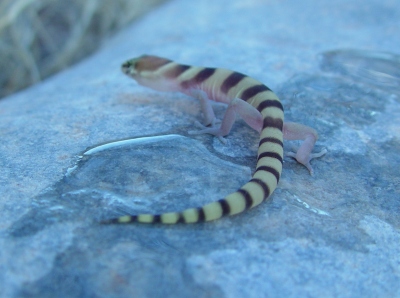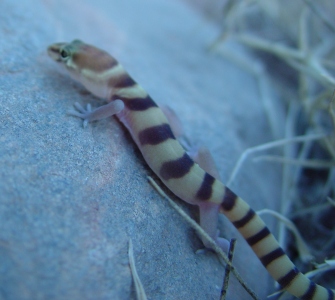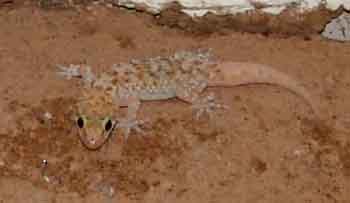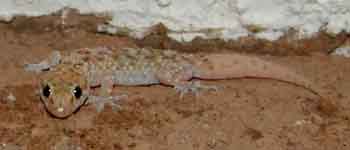Western Banded Gecko (Coleonyx variegatus)
Main sources: Stebbins, Robert, 1985, A Field Guide to Western Reptiles and Amphibians, Houghton Mifflin; Vitt, Laurie & Eric Pianka, 2006, "The Scaly Ones", Natural History July/August, pp. 28-35; Autumn, K. (see link below)
In their deep ancestry, all lizards appear to have been diurnal (active during daylight), and most major lizard groups have remained exclusively so -- enabling them to spread to habitats far beyond the tropics (by means of their practice of absorbing available sunlight to heat and energize their bodies). Only a few have developed a nocturnal adaptation, and most of these are Geckos (Gekkota). Specializing for nighttime activities limits the geographic distribution of Geckos, because low nighttime temperatures adversely affect all aspects of a lizard's physiology, but Geckos have adapted to this problem by increasing their "fuel efficiency": Kellar Autumn reports that our southwestern Banded Geckos (one of which is shown in the banner photo above) "have Cmin [minimum energy cost to move a body of given mass] 1/2 to 1/3 that of phylogenetically comparable diurnal lizards of similar mass".
Geckos are renowned for their ability not only to scale vertical surfaces but also to walk upside down, due to a distinctive molecular attraction produced by microscopic structures in their toe pads.
 ..
.. 
All photos above were taken by Grace Foreman near the San Pedro River floodplain in 2015.
Our native Gecko, member of the Family Eublepharidae (Vitt & Pianka, p. 33), is characterized by distinctly soft, smooth, pliable skin, vertical pupils, and moveable eyelids. In addition to its nocturnal habits, it is subterranean, hence seldom seen in our desert. One was encountered only because one November afternoon we lifted a large(discus-sized) rock, its imprint evident in the darkness (and dampness) of the newly exposed soil immediately surrounding the lizard, who quickly scampered off to another shelter, after a moment's hesitation when it was captured by our videocamera.
The Western Banded Gecko ranges from creosotebush flats to the pinon-juniper belt, mainly preferring rocky locations. It eats arthropods.
Today, in some parts of the city of Tucson, yards formerly occupied by the Western Banded Gecko in the 1970s now contain the intrusive Mediterranean Gecko (Hemidactylus turcicus), which has very large eyes lacking lids, and prominent, knobby tubercles all over its back, giving it an appearance of being covered with glistening sand (a very different image from the silky-smooth back of the Western Banded). It generally lacks bands (except on the tails of some young), and undergoes striking color changes from pale yellow with brown blotches to dark brown or gray. In Vitt and Pianka's classification, this Gecko would seem to belong to the family Gekkonidae. (p. 33) Two images of a single animal of this intrusive Gecko type, below, were photographed on a vertical adobe wall of a home in Tucson, and is presented here for contrast in the interest of identification. This Gecko appears to have lost, and then regrown, most of its tail. (Click on each image to enlarge it.)
 ..
..
Stebbins (p. 113) says that the Mediterranean Gecko lives mainly in or near human dwellings, and we have not seen this Gecko on Saguaro Juniper lands.
Return to Lizards
